|
THE Township of Tilbury
East, to which we came, consists of a tract of level land with clay
subsoil overlaid with black mould from decayed leaves, decomposed tree
trunks and other defunct vegetable matter. It was covered by forest
consisting chiefly of ash, beech, maple, oak, hickory, and elm, the
latter being the most plentiful. As there were few stones it gave
promise of becoming a rich farming country. At the time of our arrival,
land, in its natural state could be purchased for about five dollars an
acre, so that settlers with limited means and abundant energy had the
prospect of winning their way to independence and comfort.
PHYSICAL FEATURES
The chief drawback to the
locality was the want of drainage. As the township was bounded on the
north by the River Thames and on the south by Lake Erie, it would at
first sight appear as if drainage facilities would be abundant, but
there were special difficulties owing to the general formation of the
country. Along the river was a strip of land about a mile wide formed by
alluvial deposits from spring freshets on which an early settlement had
been made, but to the south of that was a marshy treeless plain about
two miles wide, incapable of drainage by gravitation, and so wet as to
be practically impassable. For that reason, settlement by extension from
the north was rendered almost impossible. Scarcely less difficult would
have been the extension of the settlement from the south. The bank of
Lake Erie is perhaps fifty feet above the surface of the lake but the
fall of the land northward and away from the lake is so decided that
even the rear of the lots fronting the lake can only be drained into
that outlet with much difficulty. Under these circumstances, no general
extension northerly of the Lake Erie settlement was possible without the
construction of expensive drainage works which could not be effected
without the intelligent co-operation of an organized community. There
were, however, four or five creeks or natural water-courses, at various
distances apart from each other, but all commencing some distance north
of the lake, and pursuing a northerly course through the Township, each
in its separate channel which at first is ill defined, but increases in
width and depth as it proceeds northerly until, at a distance of several
miles from their several sources, each becomes a wide depression with a
deeper channel in the centre, perhaps five or more feet below the level
of the surrounding country. On one of these, known as "Number Ten Creek"
from the number of the lot in the Middle Road Range through which it
passes, the first attempt at settlement inland was made. The adventurers
were two brothers of the name of Smith who, with their families, came
from Dumfries-shire, Scotland. They took up land at the place where that
creek crosses the Middle Road and were followed shortly afterwards by
Matthew Martin and Alexander Stevenson who occupied land about a mile to
the north. We came on the scene about thirty years later and occupied
the lot on the creek immediately south of Mr. Martin's. At the time we
arrived we had John Kerr as our neighbour immediately south of us.
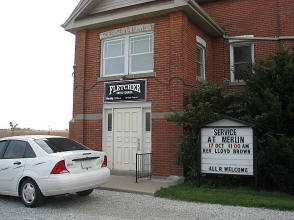
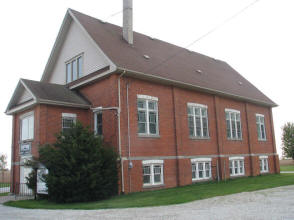
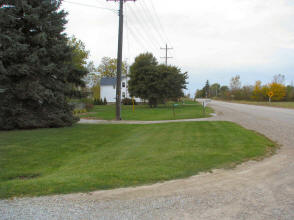
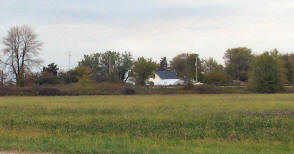
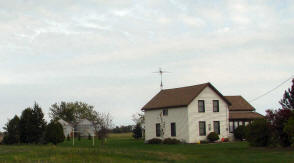

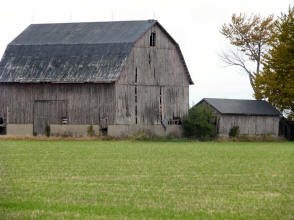
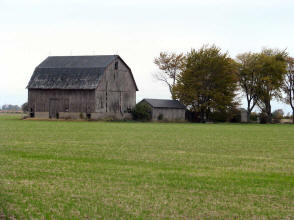

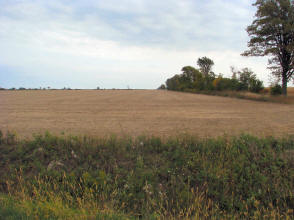
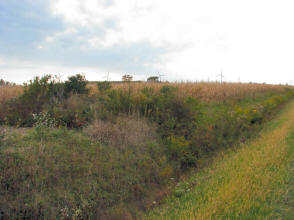
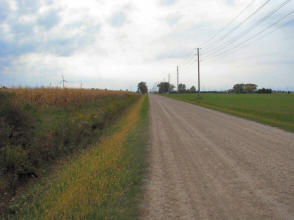
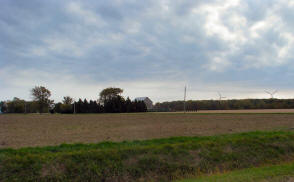
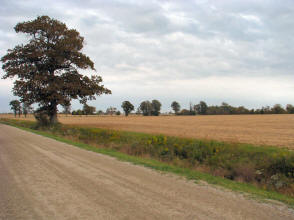

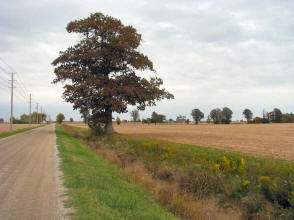
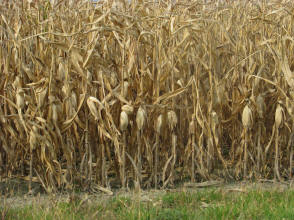
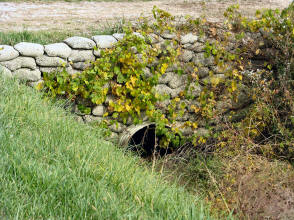
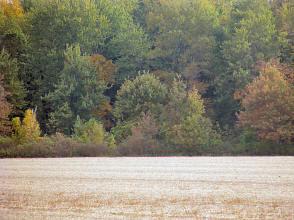
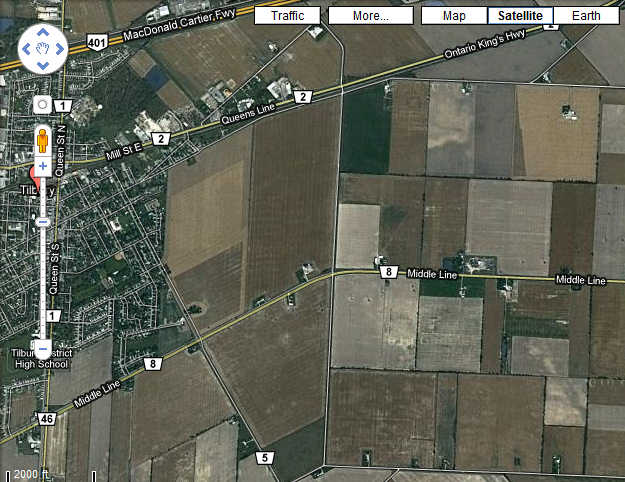
The above pictures are from around Fletcher
and Merlin which are in Tilbury East and are just to give you an idea of
what the area looks like. It is very flat but rich farmland. The picture
above is a satellite image from Google Maps showing how flat the land
is.
EARLY HARDSHIPS
Many tales were told of
privations endured by the early settlers. Uncle John Fletcher used to
tell of a time in his household when his family was reduced to potatoes
alone as food for about two weeks. He said that he noticed that as the
days passed the inadequacy of the potato, alone, as a food became
apparent from the daily increase of the quantity requisite to appease
their hunger. Of his neighbour, Mr. Stevenson, he said that the story
was current that at the same time, his household had found it necessary
to dig up for food some of the potatoes that had been planted. Mr.
Stevenson denied that he had dug up planted potatoes but admitted that
he had once found it necessary to use cuttings that had been prepared
for planting.
Not only was there
difficulty in raising from the stumpy soil food sufficient for daily
need, but there was difficulty experienced in getting their grists
ground. Some would appear to have provided themselves with a quern for
domestic use while others preferred to take their grists to Amherstburg,
and later to Chatham, by canoe. In either case it was necessary to
convey the grain and the grist across the marshy plains. Mr. Stevenson
told me that he carried his grist from the river on his back, resting
his load on the ground, when dry, and upon his stout staff when the
ground was wet. Mr. Stevenson, like many of his neighbours, found it
necessary, occasionally to interrupt his farming activities to find
employment in the United States for the purpose of earning ready money,
and such an experience may possibly have been confined to one or more of
his return journeys when shouldering, his burden was his only resource.
Be that as it may, to reach the river Thames in that day through the
unbroken forest and across the marshy plains must have been a difficult
undertaking, even on horse-back, if available. Mr. Martin, unlike his
neighbour Mr. Stevenson, never left his farm. He arrived early enough in
the season to enable him to clear off a small field on the bank of the
creek in time to get it harrowed and seeded with fall wheat the same
year, and from the time of the harvesting of that first sowing onwards,
he never found it necessary to quit the farm or to purchase the staff of
life. His family, at the time, consisted entirely of girls, but these,
in every way possible, devoted themselves to the interests of the common
household, and with their noble efforts, together with those of their
capable mother, Mr. Martin soon found himself firmly and comfortably
established as one of the most prosperous farmers in the county.
The pressing need of
roads was partly met by the construction by the Government, for military
purposes, of a road intermediate between the Talbot road along the shore
of lake Erie at the south and the road along the river Thames at the
north. This road, known as "The Middle Road," with a concession of lots
on each side, was run in a zig-zag course diagonally across the main
survey of the township, making a track of gore lots along each of "the
Back Lines" as the flanking roads were called. This road proved a double
benefit. It provided a road to Chatham round the swamp land referred to,
and it aided much in the draining of the lots situated on the southerly
side.
SMITH'S MILL.
Before the time of our
arrival, this road as well as most of the concessions had been opened
for traffic and means for supplying the primative wants of the community
abundantly provided. Grateful acknowledgement of the services done to
the community by the family of Thos. Smith was often made by the old
settlers. Starting with a simple quern provided for their own use, they
installed, first a rude ox-driven, and later, a fully equipped grist
mill driven by steam power. To this, was later added a saw-mill, all of
which was a great service to the community. The mechanical genius of the
family was Robert who showed not only skill with machinery but would
also survey boundary lines by a rude compass of his own equipment which
is now in my possession. All this machinery, with a general store
managed by the same family, was in full operation before we joined the
settlement on the creek.
Smith's Mills were, at
that time, a scene of great activity. Thither went coloured boys on
horse-back with a bag of corn to be ground into meal to make corn-bread
and mush, and farmers came from miles around with wagons and larger
grists. There too was Smith's store which had patronage from far and
near, though even froth the time of our first arrival, Valetta
competition had begun to prove a strong counter attraction. In winter
there was a constant procession of sleighs log-laden with bells
jingling, bound for the mill. The logs wpuld be sawn for lumber for the
use of the hauler, in exchange for sawing or in barter for goods from
the store. In no case was cash paid for logs. Around us therefore was
great activityŚmore in fact than was in evidence around our old home in
Scotland though the volume of money passing from hand to hand was vastly
less.
APPRENTICESHIP
Our first season was very
wet and the creek, unassisted by any drainage work, continued to flow
with its sluggish stream during the whole season. Our house which was
being built under the direction of my cousin John Fletcher, was on the
west side of the creek and though there was a road in front of it there
was as yet, no bridge. This made it necessary for all materials to be
drawn through the creek which soon became a deep mire.
The house stood well
above high water mark, but nevertheless the whole surroundings were wet
and soggy, while the creek itself, during much of the season, overflowed
its proper bounds and spread over the flats on both sides for a width of
many yards.
James and I started
forthwith to try out our own skill and the capacity of our new Canadian
axes on the trees surrounding the house and on the fallen timber, dry
and hard, with which the ground was strewn, and, with blistered hands,
succeeded in making a clearance around the house.
Our next concern was a
well. The digging part we soon completed to our own satisfaction, but
the covering of it was our difficulty. With labour we had carried on our
shoulders from the adjoining bush by wading almost ankle deep, and in
water-soaked shoes a number of idles with which we had hoped to make a
cover close enough to support a covering of clay, but were much
discouraged with our slow progress. While thus employed, Patsy Murphy, a
kindly neighbour whose shack was just across the road from us, came over
to see how we were getting on. He told us that the proper way was to use
black ash slabs for a covering. That information was of little use to us
for as yet we did not know a black ash from an elm tree, and about
splitting logs we knew absolutely nothing whatever, he then pointed to a
black ash tree standing near by and said that it would suit our purpose.
I asked how much he would take to do it for us. He mentioned a small sum
and a bargain was quickly struck, he was a splendid axe-man, and in what
we thought an amazingly short time he had felled the tree and cut it
into proper lengths. He then proceeded with axe and wooden wedges, and
what we deemed wonderful dexterity, to split the log into slabs. Our
work was then finished with ease and expedition and we soon had a good
supply of the best water obtainable.
FELLING THE FOREST
The great problem that
faced the early settlers was how to make a living while the forest was
being cut down and the soil prepared for the plough. Rejoice as he might
on the prospect of seeing some day broad fields covered with yellow
grain he needed something more substantial to feed and clothe himself
and his family in the meantime. In some sections of Canada it was
customary to clear off a piece of ground during the early summer, burn
the timber, drag the scorched ground with a harrow made in the shape of
the letter A and sow the wheat for the first crop on this surface
without the use of a plough. In Tilbury, this method was not
practicable. Ploughing and digging amongst green roots though
exceedingly laborious, was their sole resort.
SALE OF TIMBER
No revenue could be got
from the sale of timber. Even as late as the time of our arrival very
little could be made from that source. In the primeval forest there were
great oaks four and six feet in diameter at the stump and towering fifty
or more feet in height without knot or blemish. Before the time of our
arrival these had been cut and taken away in square timber, but whatever
the lumbermen made out of them, the portion that came to the settler was
small. There was still left timber that in our time had a little
exchange value. There was some oak fit for cutting into lumber planks.
Logs of maple, white ash, basswood and buttonwood were bought at the
mill, but the price paid was no more than enough to pay for the labour
of cutting and drawing. No timber that could be thus sold was wasted,
but much fine wood was unsaleable. Great hickories, towering almost like
the oaks already referred to, could not be profitably utilized for any
purpose other than to be split into fence rails or cord-wood. We used
all the timber that could in any way be made serve the needs of
ourselves or others, but after all such timber was removed there were
great numbers of huge elms and other kinds of trees that were absolutely
unsaleable.
Various means of clearing
the land were employed. Some simply girdled the trees and left them to
die in their uprightness and at leisure. Others slashed them down in
great windrows to he later burned when thoroughly dry, while those who
looked for early pasturage, or even for cultivating amongst the stumps,
made a thorough clearance by carefully piling the brush and crosscutting
the body timber to he rolled up into heaps and burned. Whatever the
relative merits of these schemes were, they all prepurpossed a long
period of hard work with practically no immediate return.
POTASH FROM ASHES
Some year before our
arrival, there was introduced a method of utilizing the ashes for the
production of potash or pearl ash. To extract this material, the ashes
were carefully gathered and placed in leaches into which they were
packed so that when water was applied the whole content would be soaked
and the contained potash carried, in the form of lye, into a large
trough. The lye was then boiled in a large kettle till all the water was
evaporated. The boiling process would last about three days, during
which about four hundred or more pailfuls would be disposed of, and the
solid matter would remain in the form of black salts. This could then be
converted into potash or pearl ash according to the refining process
adopted. This process was introduced into Tilbury East by a number of
Scottish people who had settled for a time near Montreal and hence were
known as "lower Canadians." Of them the most enterprising perhaps was
John Richardson.
To secure the best
results the timber had to be burned when green and the ashes carefully
collected so as to avoid any mixture of earth. In order to get the
timber out in piles for burning, the section to be dealt with would be
carefully examined, and if possible two large trees would be cut that
they would fall side by side. Other trees would be felled and the trunks
cut in lengths so that they could be drawn by oxen to the side of the
pile and by the use of skids and hand-spikes rolled in or piled on top.
These heaps, when completed, would be from twelve to thirty-six or more
feet in length and seven or eight feet in height. The work, as thus
indicated was laborious, and as it required several wagon loads of the
wet elm ashes to make a batch which would not realize perhaps more than
$40.00, it will be seen that its chief merit way that it enabled the
settler to keep the pot boiling while he toiled on in hope of green
fields and yellow grains.
A GLOOMY OUTLOOK
At the time of our coming
there was over the country a sense of deep depression. Owing to the
ravages of the weavel there as not enough wheat produced to feed the
population and flour was very dear. The wet season destroyed the corn
crop on which that section of country largely depended. The Reciprocity
Treaty which had done so much to encourage agriculture during the
previous ten years, was abrogated two months before we landed.
Greenbacks, as the American bills were called, were worth little more
than half their face value, and the American people had been so reduced
in circumstances that their financial power was limited. Yet, after all,
they were practically the only purchasers of our horses and cattle.
Little of their paper money was circulated in Canada but for a long time
their purchases were paid for in silver. Sometimes these coins came
rolled in cartridges with the amount in each marked by the bank, but
often they were carried loose in a sack laid on the floor of the
dealer's buggy or road-cart.
I remember buying a
plough from Mr. John Soutar in Chatham, costing $16.00 and paying for it
in full in five and ten cent pieces which I had just received the same
day for farm produce. After a time, silver became legal tender only at a
discount of some fifteen per cent, which soon had the effect of
restricting its use to service befitting its humble status.
DRINKING CUSTOMS
In clearing the country
and in raising buildings there were many tasks that required the
co-operation of a number of men. If there was logging to be done or a
building to be raised, men would cheerfully be on hand when required. No
gathering of the kind could be had however without an abundant supply of
whiskey. At the time the excise duty was small and liquor
correspondingly cheap. In the early part of the eighteenth century when
rum was first imported to England a tavern near Liverpool exhibited the
sign "A drunk for a penny, a dead drunk for twopence and straw for
nothing." Whether rates equally low were offered in Tilbury East I do
not know, but certainly drink, in large quantities was supplied and, no
doubt the other effects would follow as a matter of course. It needs no
stretch of imagination to see that as time went on many would gather in
quest of liquor rather than of service. An under-current of
dissatisfaction with the method would naturally begin to be felt,
though, for a time it would not find expression.
THE TEMPERANCE MOVEMENT
By and by, however, all
restraint was broken and the gathering storm of dissatisfaction and
disgust found utterance through the voice of Mr. John Richardson who was
not only a resourceful business man but also an enthusiastic temperance
advocate. One day it became his turn to raise a frame for a new barn.
The men invited duly assembled, but declined to commence work until they
were assured that the usual liquor provision would be forthcoming. It so
happened that Mr. Richardson was especially skilled as an axeman and as
such had been accustomed to have assigned to him the duties and
responsibilities of a "corner man." Whether the corners were to be made
on the ridge and saddle method, or with the more artistic dovetail
joints, notching the timber so as to make a neat corner true to the
perpendicular, required highly skilled workmanship. Mr. Richardson
reminded his would-be, conditional helpers that he had assisted most of
them at their railings without using a drop of their liquors and that if
they were not willing to work for him on the same terms, they might as
well go home for not a drop of liquor would he furnish whatever became
of the building. This seems to have been all that was needed to give the
sober element the lead that they required, and needless to say, the
building was duly raised, and from that time onwards, the use of drink
on such occasions steadily lost its popularity.
PROHIBITION
Another step in the
advance of temperance sentiment was marked by an Act passed in 1853 by
the Parliament of Canada which enacted that in Upper Canada the sale by
retail, of liquors in inns and taverns may be prohibited by by-law,
"provided that before the final passing of such by-law the same has been
approved by the municipality." Shortly after this law came in force the
council, presumably in response to a petition of the ratepayers, met to
deliberate on the matter. My uncle John Fletcher who was then Township
Clerk, was unable to attend through sickness. In his place he sent his
brother William, then a student for the ministry and enthusiastically in
favour of prohibition. From what I have heard, I doubt whether a
majority of the Council was favourable to the measure but they were not
hard to persuade to dispose of it by submitting it to the People in
terms of the Act. The result was that the by-law was carried
triumphantly, and though since superseded by legislative enactment, it
has never been repealed by the council, or will of the people of Tilbury
East.
Of course, in a 'Township
situated near places where drink could be procured, any one determined
to get it would have no difficulty in doing so. In Chatham there were
several taverns, and on my first journey along the "town-line" between
Harwich and Raleigh on the way to Tilbury East I noticed two not far
from the city limits. One of these was on the Raleigh side with a
sign-board on which was the picture of an old fashioned beehive with the
oft quoted words:--
"Within this hive we're
all alive
And whisky makes us funny
If you are dry, come in and try
The flavour of our honey."
A little farther on, we
passed one on the Harwich side, in front of which was the figure of a
gate and upon it an equally pressing invitation in the words :Ś
"This gate hangs high and
hinders none.
Refresh and pay and travel on."
With such a surrounding
there was no thought of forcibly depriving of liquor any who desired to
obtain it. At the same time, the closing of the local taverns, removed
from many the temptations which otherwise they were unable to resist. |
